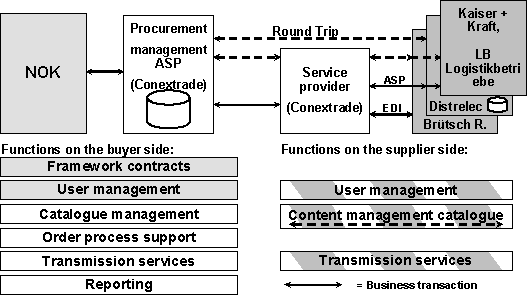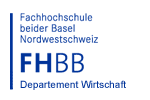Optimisation of the procurement processes for C-articles at Nordostschweizerische Kraftwerke (NOK)
Together with the cantonal power plants and close to 500 power distribution companies, Nordostschweizerische Kraftwerke (NOK) provides power to over 2.3 million residents. With the pending energy market liberalisation in mind, optimisation potential is being consistently exploited and new forms of cooperation are being sought. The electronic purchasing solutions in the ASP model (Application Service Providing) used in the nuclear energy line of business optimise the processes for purchasing C parts. This solution is characterised by a pragmatic approach, a variety of expansion options, and minimum investment costs for a professional, user-friendly application.
Inhaltsverzeichnis
1. The CompanyC-Goods
2. E-Business Strategy
3. Procurement Solution
Conextrade AG, Suppliers, Processes, Purchasing Application, Solution Concept
4. Implementation
Process Reengineering, System Architecture, Product Catalogue, Round Trip
5. Operation
Costs, Profitability
6. Success Factors
1. The Company
Change and Upheaval in View of the Market Opening Up
Nordostschweizerische Kraftwerke (NOK) was founded around 90 years ago by five cantons in Northeast Switzerland. Since then, it has fulfilled its charter for providing power. The energy necessary for this is generated by its own power plants and partner plants and it also comes from international purchase rights. It is then supplied to the regions. The individual cantonal power plants distribute power to end users and around 500 municipal power distributors.
NOK is a subsidiary of Axpo Holding, which was founded in the spring of 2001. The nine cantons in Northeast Switzerland are the owners of this holding company and they have set themselves the common goal of merging the participating cantonal power plants and NOK into a strong, future-orientated power company. The marketing, trade, and sales activities of the participating partners were transferred to the subsidiary Axpo AG and IT went to Axpo Informatik AG. The medium-term objective is complete integration into a strategic government holding.
Of over 1100 NOK employees, 450 work in the Nuclear Energy Division, where the main tasks are operating the Beznau nuclear power plant and the procurement and disposal of fuel.
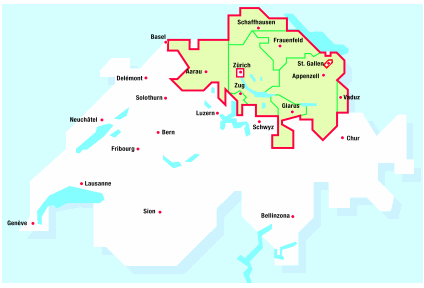
Figure 1.1: The region supplied by the Axpo Group
Market and Procurement Situation
Today, NOK is one of the most important power companies in Switzerland. Thanks to direct connections to the European integrated grid system and close cooperation with local and international partners, the company has very high reliability of supply and economical power production and procurement possibilities. In the financial year 2000/2001, it generated a turnover of CHF 1.7 billion and provided a total of 25 billion KW/h of power. Somewhat more than 20% of this was produced by the Benzau nuclear power plant.
Procurement Situation in the Nuclear Energy Division
In the Nuclear Energy Division, three persons work for materials purchasing and 1.6 personnel units take care of auditing. Procurement is regarded as an internal service and it tries to meet the needs of the departments and fulfil the company’s strategic requirements.
In purchasing, many security-related, official guidelines must be taken into consideration. Therefore, NOK organises its goods into four security groups, in addition to the usual ABC classification. Since supply reliability is very important, an above average amount of materials are kept in stock. In 2001, the value was approximately CHF 53 million with a procurement volume (without fuel) of CHF 45 million. This was largely dominated by projects for maintenance, revisions, and modernisation. A total of approximately 30,000 procurement articles were managed in the ERP system.
Supplier Relationships
There is only a limited choice of suppliers for strategically important products and components. There are only a few suppliers worldwide and various mergers in the past few years (e.g. Framatome ANP or Westinghouse Reaktor GmbH) have aggravated the situation even more. In addition, there is the fact that both the products to be purchased and their use require an extremely high level of expertise and the know-how that is necessary is only available from the respective suppliers. Therefore, these relationships are maintained by the departments, since they have the knowledge that is necessary for choosing and appraising services.
Regarding C materials, the central purchasing department is responsible for selecting, appraising, and supporting suppliers. Here, the aim is for decentralised and efficient order processing. This is to be achieved by concentrating the suppliers and using E-Procurement instruments.
Corporate Vision
NOK wants to make use of the market opening as an opportunity and regards itself as being the core of a leading and attractive Swiss energy company with an international orientation. Market orientation, employee excellence, cost leadership, and growth were defined as the most important strategic key factors.
Cost leadership is particularly applicable as a procurement objective. Here, the company is aiming for the lowest production, overhead, and financing costs, as compared to the competition.
2. E-Business Strategy
During the integration efforts, the holding company takes care of the Axpo Group’s strategic concerns. Internet technology is regarded as possessing great potential for communication and marketing in the power business. Therefore, an interdisciplinary E-Business committee was put in place at the holding level.
Since no E-Business activities were planned on the procurement side, and the purchasing manager of the Nuclear Energy Division wanted to develop the multi-faceted potential of new instruments, he personally took the initiative. The project was not supposed to create any prejudice within the Axpo Group and only make minimum demands on the organisation. Thanks to the trend-setting role of this division, Axpo will be able to make use of this E-Procurement experience throughout the Group. In order to support this process, Axpo Informatik was involved in the project as an observer.
3. Procurement Solution
Starting Situation and Requirements
Due to the regulated environment, the historical development of procurement processes is strongly orientated around paper and they were processed undifferentiated for a long time. Consequently, internal investigations revealed that the cost of processing an order approached CHF 270. This was an amount that bore no acceptable relationship to the value of the order, in particular for C parts, which are not subject to any special security regulations. The central purchasing department was too strongly involved in the administrative work of the ordering process. Of the ca. 4000 orders entered into SAP/R3 each year, 900 so-called telephone orders were entered by the purchasing department into SAP with a reduced data record for later auditing. The approximate 600 office supplies orders per year were made directly by the departments and not shown in the system.
The future E-Procurement solution was supposed to reduce the number of telephone orders, simplify the ordering of uncritical C parts for all the persons involved, as well as create increased transparency in the process and for office material orders. The choice of solution was determined by the following conditions:
- exhausted investment budget
- Axpo Informatik was undergoing a change process and was only to be used marginally
- scalability and further development of the solution in the SAP environment]
- a high degree of user-friendliness in the application
- continuation of the cooperation with the existing quality suppliers
Partners
A well-known consulting company offered NOK a preliminary study for a fully integrated solution based on Enterprise Buyer Professional from SAP. However, the project and investment costs would not have resulted in an acceptable payback time for the planned area of application. Ultimately, NOK decided to forego a detailed preliminary study because in view of the complicated procurement processes, there was an obvious optimisation potential. Under the given circumstances, using an ASP solution and connecting suppliers via a trading centre proved to be the ideal approach to the problem, and also fulfilled the requirements of scalability and expandability. NOK decided in favour of the purchasing management ASP solution from Conextrade.
Conextrade AG – Procurement Service Provider
This fully owned subsidiary of Swisscom AG has approximately 75 employees and operates the leading electronic trading centre in Switzerland. Conextrade connects processes and systems between business partners and guarantees the exchange of various forms of data. Depending on the existing system environment, various versions of end-to-end integration are used, right up to ASP solutions. Catalogue and content management are as much a part of Conextrade’s range of services as are extensive E-Services (e.g. online buying & selling auctions).
Suppliers
Early on, NOK sought meetings with four of its most important suppliers of regularly purchased, uncritical C articles. Distrelec, Kaiser + Kraft, and BrĂĽtsch RĂĽegger already had business relationships with Conextrade. LB Logistikbetriebe had to be won over to the new form of cooperation. The following criteria were taken into consideration for the choice of suppliers:
- purchase volume and number of procurement processes
- uncritical goods without specific security regulations
- availability of the required electronic article data
- high degree of coverage for the assortment (supplier concentration)
The following material groups were covered: office supplies, work and radiation protection, operation equipment, hand tools, electrical materials.
Processes, Roles, and Functions
After deciding in favour of a solution, NOK and Conextrade began modelling the concept and defining the processes and roles.
NOK
The central purchasing department continues to choose the suppliers, determine the assortment, and finalise framework contracts. The purchasing solution ensures that more processes will be processed within the framework contracts. Central purchasing manages the users that are registered on the platform.
There are no plans for the meantime to integrate into SAP. First, NOK wants to gain some experience and keep the complexity to a minimum. NOK even decided against including support for the sub-processes for auditing and payment, in the first step, although in the analysis of the process costs, major savings potential was identified here. NOK will carefully evaluate this next step, particularly since such a project has a much greater scope.
The cost centre managers and the purchasing department were provided with more transparency and better management information through meaningful analyses.
Each consumer is assigned to an ordering party within his/her department or group. Orders valued at over CHF 1000 are automatically transferred to an approving party for release. Individual limits, orientated around the underwriting regulations, are defined for the approving parties. The approval procedure covers a maximum of two levels of hierarchy. NOK is striving to keep the number of approvals that are required to a minimum. However, at the same time, the ordering parties are being requested to avoid smaller orders and to collect incoming orders in the shopping basket until a reasonably sized order per supplier has been reached. If a need has been established, the ordering party logs in to the platform using the Internet, looks for the respective products in the electronic shopping catalogue, and puts them in the shopping basket. Just one click is necessary to place the order, since all the necessary information for each ordering party has been preset, including the cost centre and material group.
Figure 3.1 shows by example the tasks and process steps (white) respectively that occur for a telephone order. The light grey fields stand for process steps that are recently being transacted on the electronic medium. Major savings resulted from eliminating the written purchase requisition (BANF) and the checking steps.
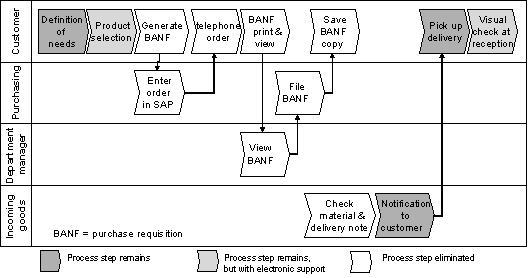
Figure 3.1: Change to the former standard process for “ordering by telephone”
Suppliers
The chosen suppliers are responsible for preparing and managing their electronic product data in the format required by the platform operator. In addition, they must guarantee availability of the agreed articles and guarantee expedient processing of the incoming orders.
Procurement Service Provider
The purchasing application is operated by Conextrade. This service includes access to the procurement software via Internet and management of the suppliers’ catalogues. The assortment of the defined suppliers is largely shown in a customer-specific catalogue. Conextrade immediately transmits the orders that are placed by the users to the respective suppliers in the requested format.
Figure 3.2 is a schematic representation of the described relationships. The functions that are necessary for the outlined solution are shown under each party. If they are used by NOK or alternatively the suppliers, then they are highlighted in grey. The white fields describe the services rendered by the service provider on behalf of the party. The striped surfaces indicate that the function can be fulfilled by both participating partners.
4. Implementation
Redesign of the Processes [Process Reengineering]
After deciding in favour of a solution, the central purchasing department of the Nuclear Energy Division first began by making detailed records of the procurement structures and processes in the departments and their requirements. The analysis was used at the same time to involve the affected parties in the project at an early stage.
The procurement manager and initiator of the project took responsibility for managing the entire project. He assumed responsibility for communication and project marketing, planning, compliance with internal guidelines, as well as for defining the supplier portfolios. The project manager from Conextrade supported him in methodological issues, in particular since an IT project was new territory for the procurement management. The interdisciplinary team included representatives from procurement, specialist departments, Axpo Informatik and Conextrade.
Conextrade trained three persons as administrators and created a user’s guide. The purchasing manager took personal responsibility for training the ordering parties and approving parties. After some initial meetings involving NOK and the chosen suppliers, Conextrade took over responsibility for supporting them in order to prepare jointly the content that was required for the solution. The supplier that still had no relationship with Conextrade had its own E-Shop and was initially disappointed that its services did not meet the requirements of NOK. However, in the course of the meetings, the supplier recognised the potential of a connection and decided in favour of the “Sales Management ASP” solution. In particular, the convenient scalability when servicing other customers using this trade platform was a decisive argument.
Altogether, there are approximately 50 ordering parties and 25 contributing parties registered as so-called approving parties on the platform. No resistance was felt on the part of the users and consumers. On the contrary: use of the Internet for purchasing through a supplier’s E-Shop had already been requested earlier by various parties. Process savings and the reduction of administrative overhead was enough motivation for all ordering parties to agree to the new tool.
From the kick-off meeting to productive use in January 2002, the project took five months, whereby it is worth mentioning that NOK was not under any time pressure and both the business set-up and the user training was conducted thoroughly.
Technical Platform/Architecture [System Architecture]
The platform of the ”Purchasing Management ASP” product from Conextrade is based on Enterprise Buyer Desktop 2.0 software from Commerce One. This product was originally a joint development of SAP Market and Commerce One. A product from Requisite Technologies was used for processing catalogue data on the platform. The product catalogue is part of Enterprise Buyer Desktop as is user management and the database containing the orders. SSL 128-bit encryption is used for web-based access to the application.
On the supplier side, Conextrade provides a way to exchange orders electronically (via EDI, XML, etc.) or to process them over the Internet (Sales Management ASP). This application was developed by Conextrade and is based on webMethods. It was also possible to transmit the invoices electronically. In NOK’s case, this is still done on paper.
The hardware of the trade platform is operated in the Swisscom computer centre.
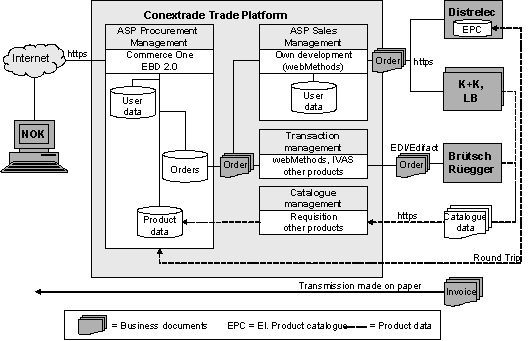
Figure 4.1: Architecture of the NOK solution
Provision of Electronic Product Data
The product data in the outlined solution is provided either by means of the shopping catalogue or by something called a round trip (compare to Fig. 4.1). These two options should be explained in more detail.
Shopping Catalogue
The product catalogue is part of Enterprise Buyer Desktop 2.0. Product data from the suppliers is kept in a customer-specific shopping catalogue. The product data necessary for this can be transmitted by e-mail to Conextrade as an Excel, MS Access, or TXT file or uploaded to the trading centre via Internet. First of all, the entire contents of the catalogue are sent and thereafter only delta updates are periodically sent with the changes. Product and price data as well as pictures and attached documents are sent in separate files. In an additional step, Conextrade processes the data, if necessary, and converts it into the format required to keep it in Enterprise Buyer Desktop. The products are classified according to UN/SPSC. After this reworking is completed, the purchasing manager is sent an Excel file for inspection and release.
In principle, NOK could provide an individual catalogue to each ordering party. At the moment, there are still no requirements for this. As the size of the assortment increases, this option will be reviewed so that the ordering parties can find their requirements efficiently and avoid sections of the assortment they do not require.
Round Trip
There is a way for suppliers that have assortments with volatile prices or configurable merchandise to link up to a procurement application through a round trip. Here, the application accesses the product data in the supplier’s E-Shop, puts together a shopping basket and eventually puts it into the procurement application with the data that is necessary for the order using an OCI interface (Open Catalogue Interface). The round trip does not initiate an order in the supplier’s shop. The order will be sent to the respective supplier in the requested format using the electronic trading centre. This form of connection does not support a multi-supplier assortment search and requires that the ordering parties deal with respective designs at each E-Shop. On the other hand, in this alternative, they are shown more in-depth information and resources (configuration and decision aids, inventory levels, new products, etc.) than in the shopping catalogue, which can be of great added value, depending on the type of product.
5. Operation
Maintenance
NOK only has a minimum amount of work from operating the solution. The purchasing manager and his team provide 1st level support and are responsible for user management as well as introducing new ordering parties. He analyses the needs in order to identify additional suppliers or material groups that would be worth- while processing with this procurement solution.
Conextrade maintains the solution, guarantees smooth operation, and provides ongoing development of the platform in accordance with the customer's needs. The company supports NOK administrators (2nd level support) and accompanies new suppliers when they connect to the trading centre.
Benefits
The ordering parties profit from having up-to-date information, ordering within the terms of agreed contracts, and have considerably less administrative work per order. Consequently, they can concentrate more intently on their core activities. The ordering process is considerably more transparent, which saves time-consuming further enquiries to various departments. The application makes it possible for cost centre managers to obtain analyses based on ordering party, cost centre, or material group. The central purchasing department is relieved of administrative tasks and can increasingly dedicate itself to work that has a higher creation of value.
Costs
Conextrade’s pricing model is strongly orientated towards the requirements of customers and is increasingly orientated towards the added value that the customer generates through the solution. Therefore, it is not possible to generalise costs.
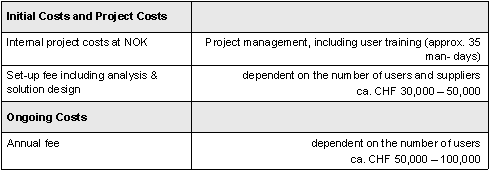
Ongoing Costs
Depending on the number of users, the annual fee is approx. CHF 50,000 – 100,000.
The costs that a supplier incurs for connecting to the trading centre are influenced by the quality of the existing electronic product data and the requested depth of integration into its own systems and processes. The following table shows by example the costs for sales management in the ASP model.
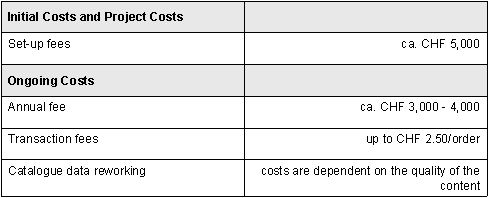
Profitability
Internal calculations showed that by using the ASP solution presented here, costs for the ordering process were reduced from a former CHF 270 to CHF 140 per order. If the process of auditing and payment were integrated on the customer side, then the processing costs would be approximately CHF 80.
In view of the restrictive personnel policies, the Nuclear Energy Division assumes that the savings will actually be achieved by the ordering parties being able to concentrate more intently on their core activities. In addition, with the merger to Axpo Nuclear Energy in mind, more efficient structures and thereby an optimised starting situation will be created. NOK expects a payback time of less than one year for the initial costs and projects costs.
6. Success Factors
Specialities of the Solution
The purchasing management ASP solution from Conextrade provides a professional application with mature business logistics for a worthwhile price, even for medium-sized companies. It makes it possible to have gradual integration of the processes and systems of the participating partners on both the buyer’s side as well as the seller’s side. Consequently, as the next step, NOK is checking out the electronic transfer of order and invoice data to SAP/R3, through which auditing and release for payment will be simplified and cash management optimised.
The connection to the trading centre helps NOK reduce the complexity of integrating business processes and systems, and makes it possible to profit from the specific competence of the service provider.
Changes
The solution that was introduced greatly relieves central purchasing and provides the information that is necessary to control procurement. By means of the shopping catalogue, central purchasing can specify the assortment, which is also important for compliance with industrial safety requirements and consequently can guarantee that the highest possible percentage of processes are transacted within the terms of framework contracts. The discussion about supporting common business processes led to a higher quality of supplier relationship.
The solution resulted in interfaces, media disparities, paper files, and time-consuming further enquiries being decisively reduced. This contributed to greater acceptance of the solution among the ordering parties. The increased transparency and considerably shorter cycle time resulted in fewer products being kept in stock. Rules regarding minimum order values resulted in the active use of functions such as saving shopping baskets and order lists.
It is no longer necessary for cost centre managers to view the order requests; they only have to release electronically orders valued at more than CHF 1,000. At the same time, they have been given more transparency and the desired control thanks to the reporting functionality.
Through the use and acceptance of this web-based purchasing solution, users are building up competence in the use of Internet technology.
Lessons Learned
E-Procurement affects far more positions than only procurement, therefore an interdisciplinary project team should be put together in which all affected stakeholders are represented. The following items must be observed for the acceptance and workability of the solution:
- earlier involvement of users and suppliers in the project
- an initial selection of suppliers that have an assortment which is important to the ordering parties but still not critical to business
- realistic objectives, careful set-up and testing of the solution
- the users and organisation must not be overburdened by complex applications or changes
- project marketing and open communication that does not create unrealistic expectations
Summary
The introduction of the ASP solution from Conextrade and the change processes that have been completed have resulted in procurement within the Nuclear Energy Division being of greater service to the company within a very short time and it has realised considerable savings potential. The most important success factors were visionary senior management, high dedication of procurement management, open corporate culture, innovative suppliers, and partnership-like cooperation with solution providers.

